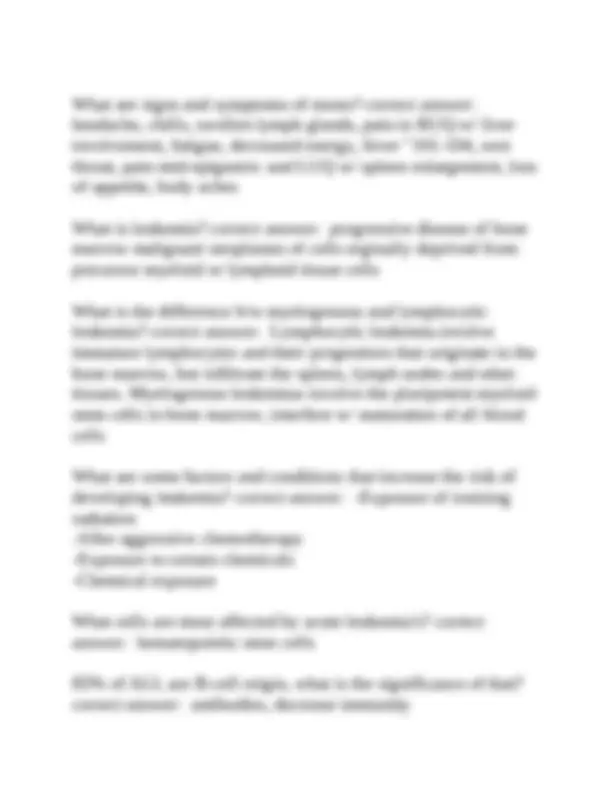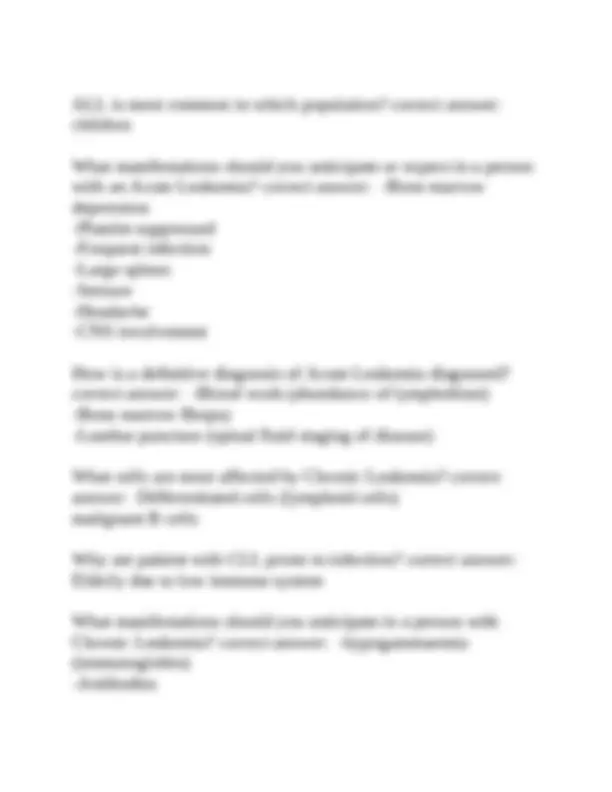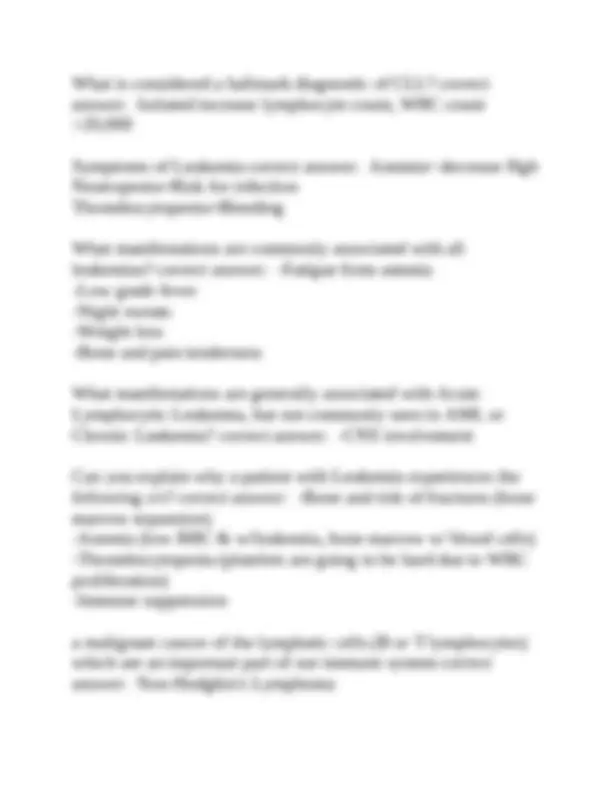






Study with the several resources on Docsity

Earn points by helping other students or get them with a premium plan


Prepare for your exams
Study with the several resources on Docsity

Earn points to download
Earn points by helping other students or get them with a premium plan
Community
Ask the community for help and clear up your study doubts
Discover the best universities in your country according to Docsity users
Free resources
Download our free guides on studying techniques, anxiety management strategies, and thesis advice from Docsity tutors
A comprehensive overview of the hematopoietic and lymphoid systems, focusing on disorders of white blood cells (wbcs) and lymphoid tissues. It includes definitions, causes, clinical courses, and manifestations of various conditions, such as neutropenia, infectious mononucleosis, leukemia, and lymphoma. The document also explores the differences between myelogenous and lymphocytic leukemia, the risk factors associated with leukemia development, and the characteristic features of multiple myeloma. It is a valuable resource for students studying hematology and related fields.
Typology: Exams
1 / 8

This page cannot be seen from the preview
Don't miss anything!





What is the Hematopoietic systems' and Lymphoid Systems' Responsibility/Purpose? correct answer: "Generation and regulation of blood that function in the transport oxygen, defend against microorganisms, preserve integrity of vascular system. What makes up our blood? correct answer: -Blood cells (Leukocytes, aka WBC, Thrombocytes/Platelets, and erythrocytes/RBC) -Plasma (fluid that carries the blood cells) Where do blood cells originate? correct answer: Bone marrow Define leukopenia correct answer: describes a decrease in the absolute number of leukocytes in the blood Define agranulocytosis (aka Neutropenia) correct answer: denotes a virtual absence of neutrophils -1st line of cellular defense not there Discuss the causes and clinical course of Neutropenia correct answer: Causes: bacterial and fungal infection (Respiratory, skin, nose mouth) Clinical course: blood cancer, chemotherapy, radiation therapy, systemic lupus
What is the person with Neutropenia at most risk for and WHY? correct answer: bacteria infections due to neutrophils being low What is Infectious Mononucelosis and what causes the disorder? correct answer: excessive, self-limiting lymphoproliferative disorder caused Epstein Barr virus Discuss how Mono is transmitted and who is most likely to contact the disorder and WHY? correct answer: -spreads from person to person primarily through contact w/ infected oral secretions -young children in crowded conditions, where there is considerable sharing of oral secretions What is the onset of mono? correct answer: insidious (slow progressive), incubation, sore throat, swollen lymph nodes What are the manifestations of mono? correct answer: hepatitis and splenomegaly What are the changes in lab work for mono? correct answer: increase in the number of leukocytes, WBC count elevated, hetrophil antibodies What is the recovery period for mono? correct answer: acute phase last 2-3 weeks, after which recovery occurs rapidly How is mono transmitted? correct answer: most common age 15-24 yrs Contracted through saliva, mucus and tears known as the "kissing disease"
ALL is most common in which population? correct answer: children What manifestations should you anticipate or expect in a person with an Acute Leukemia? correct answer: -Bone marrow depression -Platelet suppressed -Frequent infection -Large spleen -Seizure -Headache -CNS involvement How is a definitive diagnosis of Acute Leukemia diagnosed? correct answer: -Blood work (abundance of lymphoblast) -Bone marrow Biopsy -Lumbar puncture (spinal fluid staging of disease) What cells are most affected by Chronic Leukemia? correct answer: Differentiated cells (lymphoid cells) malignant B cells Why are patient with CLL prone to infection? correct answer: Elderly due to low immune system What manifestations should you anticipate in a person with Chronic Leukemia? correct answer: -hypogammaemia (immunoglobin) -Antibodies
What is considered a hallmark diagnostic of CLL? correct answer: Isolated increase lymphocyte count, WBC count
20, Symptoms of Leukemia correct answer: Anemia= decrease Hgb Neutropenia=Risk for infection Thrombocytopenia=Bleeding What manifestations are commonly associated with all leukemias? correct answer: -Fatigue from anemia -Low grade fever -Night sweats -Weight loss -Bone and pain tenderness What manifestations are generally associated with Acute Lymphocytic Leukemia, but not commonly seen in AML or Chronic Leukemia? correct answer: -CNS involvement Can you explain why a patient with Leukemia experiences the following s/s? correct answer: -Bone and risk of fractures (bone marrow expansion) -Anemia (low RBC & w/leukemia, bone marrow w/ blood cells) -Thrombocytopenia (platelets are going to be hard due to WBC proliferation) -Immune suppression a malignant cancer of the lymphatic cells (B or T lymphocytes) which are an important part of our immune system correct answer: Non-Hodgkin's Lymphoma
staging is much more important in guiding therapy-some area, localized What is a distinctive feature/ diagnostic of Hodgkin Lymphoma? correct answer: morphological, large, atypical, mononuclear tumor cells Which disorder appears to increase the risk of developing HL later in life? correct answer: mono in the past What features/manifestations are the same in both lymphomas? correct answer: -Swollen lymph nodes -Enlarge lymph nodes -Fever -Weight loss -Night sweats -Increase Risk for Infection What features/ manifestations for Non-Hodgkin? Location and spread correct answer: Location: all over Spread: -Poor humoral immunity -Hypogammaglobinemia What features/manifestation for Hodgkins? Location and Spread correct answer: Location: above diaphragm Spread: -Pruritis-itching of skin -Impaired cellular immunity
What is multiple myeloma and what risk factors predispose a person to it? correct answer: B-cell malignancy of terminally differentiated plasma cells What are characteristic features of multiple myeloma? correct answer: -proliferation of malignant plasma cells in the bone marrow and osteolytic -bone lesions throughout the skeletal system -Abnormal proliferation of marrow plasma cells -Proliferation and activation of osteoclast -MM protein What manifestations should lead you to suspect Multiple Myeloma? correct answer: -Calcium elevation -Renal impairment -Anemia -Bone -Bone pain, usually in the back and ribs -Broken bones, usually in the spine -Frequent infections and fevers